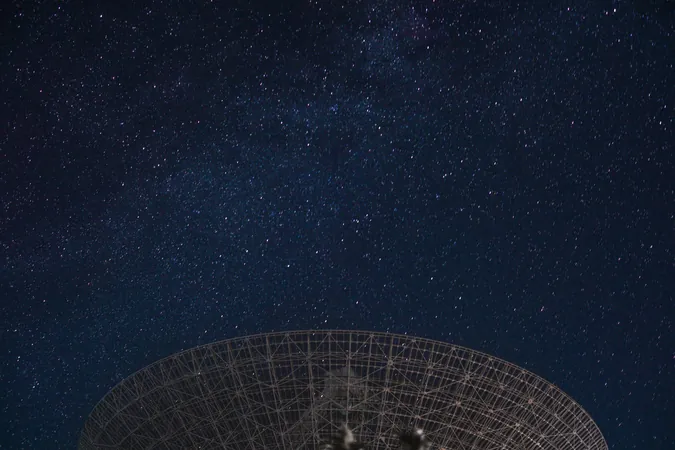
Unraveling the Mystery: How Scientists Pinpointed the Source of a Fast Radio Burst!
2025-01-01
Author: Michael
Introduction
Fast radio bursts (FRBs) have captivated astronomers since their first discovery in 2007. These enigmatic phenomena are characterized by brief, powerful explosions of radio waves emitted by extremely dense cosmic entities, such as neutron stars and potentially black holes. Lasting only a fraction of a second, these bursts can unleash energy levels that momentarily outshine entire galaxies, leaving scientists scrambling to understand their origins.
Groundbreaking Study
In a groundbreaking study published in Nature, a team of researchers from MIT has made significant strides by pinpointing the source of one particular FRB, designated FRB 20221022A. Detected from a galaxy situated about 200 million light-years away, this discovery marks an important milestone in the ongoing quest to uncover the underlying processes driving these cosmic events.
Novel Technique and Findings
The team employed a novel technique centered around the analysis of the FRB's "scintillation" – the phenomenon where bright light sources appear to twinkle as their signals pass through interstellar gas. This observation allowed scientists to assess the burst's brightness fluctuations, indicating that FRB 20221022A likely originated from a region much closer than earlier models had suggested. The newfound estimate pins the explosion's source at a mere 10,000 kilometers from a rapidly spinning neutron star – an astonishing distance that is less than the span between New York City and Singapore.
Magnetosphere and Radio Emissions
This research provides strong evidence that FRBs can arise from the neutron star's magnetosphere, a highly magnetic and turbulent region surrounding such dense celestial bodies. "The magnetic fields in these environments are among the most intense found in the universe," explained lead author Kenzie Nimmo from MIT's Kavli Institute for Astrophysics and Space Research. "It's been a topic of heated debate whether such intense radio emissions could escape this extreme plasma."
Unique Characteristics of FRB 20221022A
Interestingly, FRB 20221022A exhibited a unique characteristic; the emission was highly polarized, following a smooth S-shaped pattern. This feature is reminiscent of pulsars, which are rapidly rotating neutron stars known for their magnetic properties. The significant discovery suggests that this FRB likely originated in the immediate vicinity of a neutron star, providing a crucial piece to the complex puzzle surrounding these bursts.
Role of CHIME
A notable contributor to the detection of FRBs has been the Canadian Hydrogen Intensity Mapping Experiment (CHIME), which has identified thousands of FRBs since its operational debut. Scientists continue to explore the mechanisms behind these cosmic events, revealing a diverse range of theories regarding their origins, from turbulent magnetospheres to shockwaves propagating far from their source.
Implications of the Research
By focusing on scintillation, the researchers could estimate the size of the region from which the FRB originated. The findings revealed that the gas present within the FRB's host galaxy served as a natural lens, enabling a closer look at the burst's source and confirming its close proximity to the neutron star.
Conclusion
The implications of this research are profound. The studies confirm that fast radio bursts can indeed emerge from chaotic magnetic environments rather than distant shockwaves as previously theorized. "This discovery can significantly influence future research into the underlying physical mechanisms that generate these bursts," remarked Kiyoshi Masui, an associate professor of physics at MIT.
Looking Ahead
With CHIME detecting multiple FRBs each day, the researchers believe that the scintillation technique they employed will be invaluable in unraveling the complex physics behind these fascinating cosmic occurrences. As we continue to investigate and understand these mysterious blasts from the cosmos, who knows what other secrets the universe has in store for us? Stay tuned as we unravel more of the cosmos' deepest mysteries!



 Brasil (PT)
Brasil (PT)
 Canada (EN)
Canada (EN)
 Chile (ES)
Chile (ES)
 Česko (CS)
Česko (CS)
 대한민국 (KO)
대한민국 (KO)
 España (ES)
España (ES)
 France (FR)
France (FR)
 Hong Kong (EN)
Hong Kong (EN)
 Italia (IT)
Italia (IT)
 日本 (JA)
日本 (JA)
 Magyarország (HU)
Magyarország (HU)
 Norge (NO)
Norge (NO)
 Polska (PL)
Polska (PL)
 Schweiz (DE)
Schweiz (DE)
 Singapore (EN)
Singapore (EN)
 Sverige (SV)
Sverige (SV)
 Suomi (FI)
Suomi (FI)
 Türkiye (TR)
Türkiye (TR)
 الإمارات العربية المتحدة (AR)
الإمارات العربية المتحدة (AR)